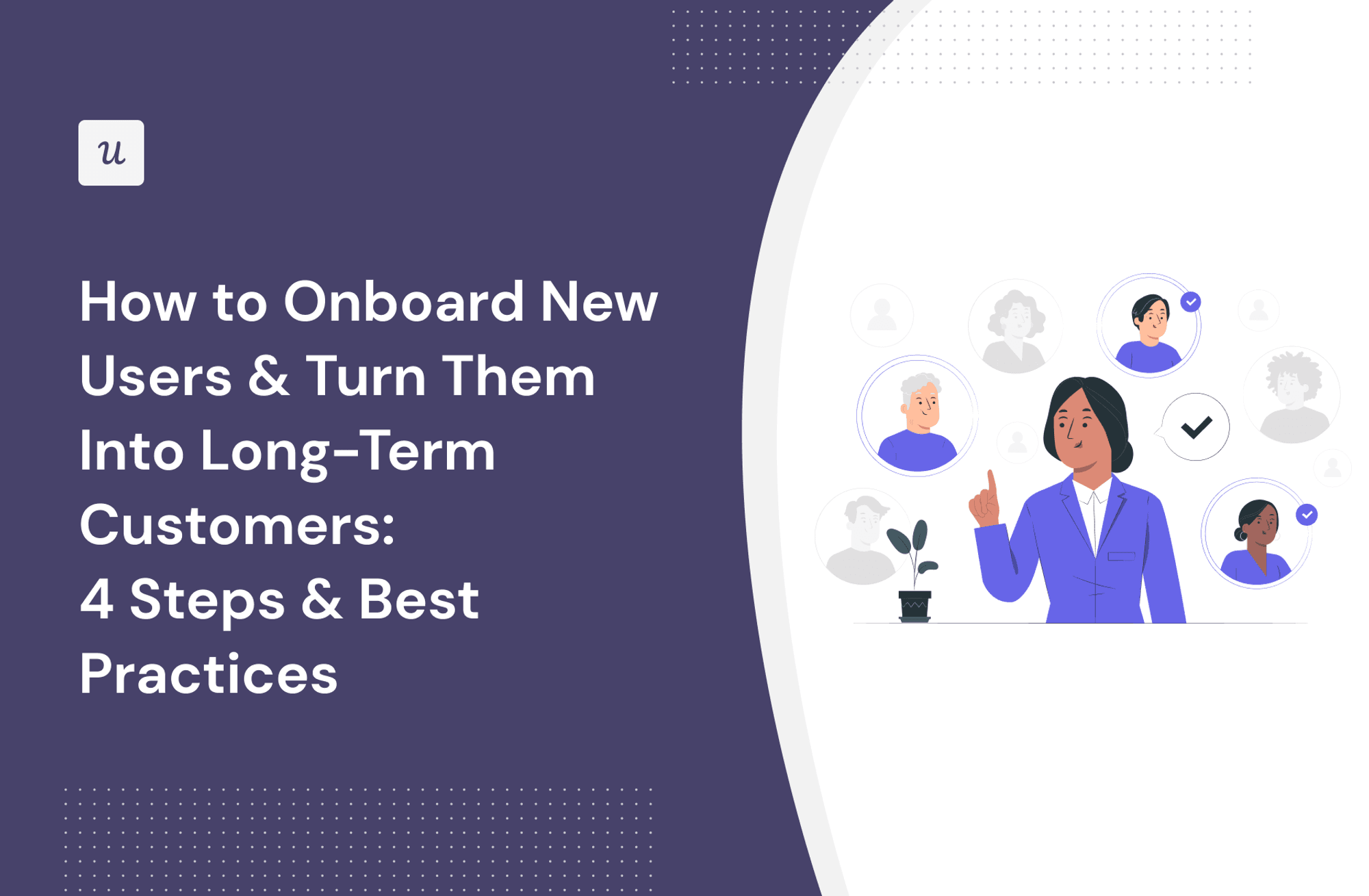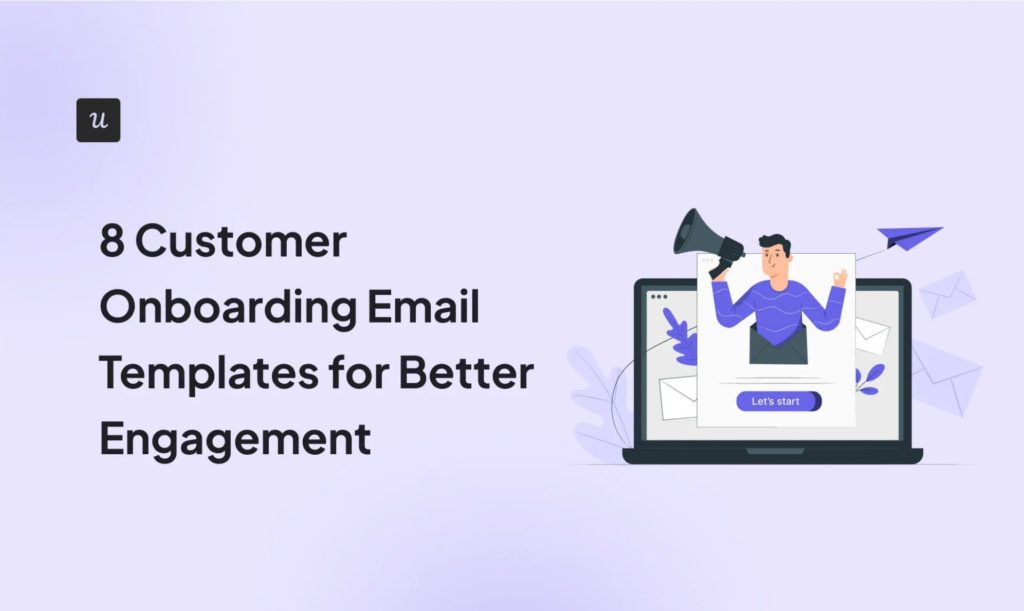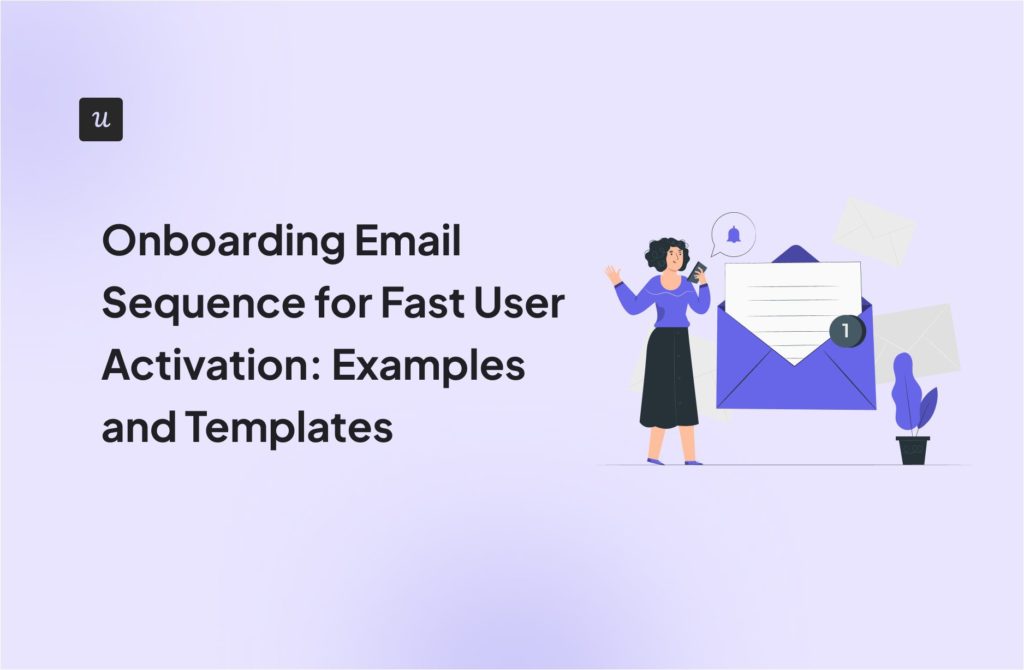
How to Onboard New Users & Turn Them Into Long-Term Customers: 4 Steps & Best Practices
Struggling to learn how to onboard new users? Trust us, you’re not alone.
User onboarding can be tricky, even for the best of us. That doesn’t make it any less important. If anything, a successful onboarding process is now a necessity, as it may just be the only thing standing between retention and churn.
But how do you design onboarding flows that get new users to stick around? We’ve got all the answers right here! So let’s dive in and start creating the most effective onboarding experience for your new users.
Get The Insights!
The fastest way to learn about Product Growth, Management & Trends.
What is new user onboarding?
New user onboarding is the process all new users go through to get acquainted with your product and learn how they can best use it to solve their problems.
In other words, the user onboarding experience is meant to help new users quickly unlock the value of your product. The quicker they realize value by using your product, the less likely they are to churn.
Despite common misconceptions, user onboarding is not the same as giving new users a product tour. Instead, these tours are just one part of your onboarding process, to be used alongside other complementary elements, such as a signup form, welcome screen, and tooltips.
Why is user onboarding important?
New user onboarding seems like a lot of work, so of course you’d like to know, “Why do it?”
We’re glad you asked because there are numerous reasons why every SaaS company should focus on its onboarding flow. Some of these advantages are discussed below.
- Increase customer satisfaction: Helping new users learn an unfamiliar product instead of leaving it on their own makes them feel at ease and taken care of, which translates into improved satisfaction.
- Drive product adoption: New users won’t adopt a product unless they know how to derive value from it. Onboarding flows can showcase how to do that so users learn how to effectively use your product.
- Prevent churn and increase user retention: A well-designed onboarding experience helps reiterate that the new user has already picked the best product and doesn’t need to look for alternatives.
- Improve user engagement: Providing new users with contextual help when needed keeps them engaged. If you didn’t offer such guidance, new users would disengage every time they experienced friction.
How to create a successful user onboarding process?
Designing the optimal new user onboarding process might sound a bit daunting. However, it isn’t.
All you need to know are the four basic steps that all successful user onboarding flows have in common.
You start by focusing on your users’ needs, and you end by tracking and improving your onboarding process as needed. It is that simple!
1. Understand your customers’ JTBD
Before you start anything, you need to do your homework. This means figuring out what different users are hoping to achieve by using your product. In other words, what their JBTD is.
Use welcome surveys like the one shown below to collect such data about the user’s use case. Next, based on the survey data, divide the new users into various personas.
This way, you’ll know what the end goal is for each persona, thereby helping you personalize onboarding.

Welcome survey to collect user data.
2. Define the activation point for each of your user personas
User activation is the point where users, whether new or existing, start deriving real value from your product. Various user personas have different activation points. What counts as good value for money for one user might not be true for another.
To find the activation point, track the product usage of power users to identify behavioral patterns. From these patterns, determine the core features that bring them value and all the steps they complete to start effectively using these features.
Lastly, segment all this data by personas. That’s it, now you’ll have the unique activation points for each persona.

3. Segment customers to trigger personalized user onboarding flows
The next step is to use data collected in the previous step to segment customers by grouping those with similar goals.
Then, based on which segment a new user belongs to, you can trigger personalized onboarding flows.
This will help teach new users about key features relevant to their JBTD, instead of showing them generic onboarding processes that benefit no one.

4. Measure, iterate, and improve your user onboarding flow
Creating a truly helpful new user onboarding experience requires consistent tracking to see how your onboarding process is performing. And then this is followed by tons of iterations and constant improvement.
To measure how you’re doing, analyze the onboarding funnels to identify which ones lead to churn. Focus on finding the steps users get stuck at and disengage after. These are called friction points, and they ruin the customer experience.
Then simply tweak the individual steps of that funnel to reduce friction and improve the user onboarding experiences.

10 Best practices for a great user onboarding experience
By now, you know the basic steps of creating a new user onboarding process. Next, it’s time to learn how you can take that onboarding experience from good to great.
To help you do that, we’ve compiled a list of the 10 best practices that can elevate your onboarding. Let’s take a look at what these are!
1. Personalize the user onboarding experience for new users
A generic onboarding process just for the sake of it isn’t going to help anyone.
Instead, try personalizing the user onboarding. This way, engagement increases since the onboarding is relevant to the user’s use case and helps reduce time to value.
Notion does this brilliantly through its branched onboarding. It uses a welcome screen to collect information about why the user needs Notion and then customizes the onboarding accordingly.

2. Invite users to a one-on-one demo call and give them a head start
If your product or service is complex or requires data migration, setup, and implementation, then this tip is definitely for you.
The more complex the product gets, the more guidance new users need. Provide that guidance through white-glove onboarding and product demos, where you invite users to face-to-face calls for hyper-personalized help to get them started.

3. Point users toward key actions with checklists
Humans tend to remember unfinished tasks more often, putting them in a state of tension as they feel compelled to complete the pending tasks. This user psychology phenomenon is called the Zeigarnik effect.
Take advantage of this effect by using onboarding checklists to remind users of their uncompleted tasks. With such checklists, you help ease the mental load on new users, as they don’t have to keep track of everything on their own anymore.
This way, with the structured help of checklists, new users are more likely to reach activation sooner. Plus, you can also personalize the checklists according to the user’s goals, thereby further improving the activation rate.

4. Use interactive walkthroughs to drive feature adoption
Interactive walkthroughs handhold users step-by-step through using a feature and help them gain immediate value from it.
These interactive guides embrace progressive disclosure, which means introducing more complex information gradually to not cognitively burden users. Thus, they’re a great way for users to learn without feeling overwhelmed.

5. Provide contextual guidance with UI patterns to reduce friction
To further ease the onboarding process, try using in-app messages. Set up triggered messages based on user actions to guide them toward specific actions. You could also use these messages to offer contextual solutions on the spot when users experience friction.
For example, let’s say a user is struggling with a feature. Even when you track usage, you see that the user disengages when they start interacting with that feature.
You could trigger in-app messages or tooltips, like the one shown below, providing a possible solution, such as asking users to revisit the feature guide.

6. Offer self-service options to improve customer experience
Self-service support provides users with the resources they need to find solutions to their problems independently and move ahead seamlessly.
It empowers them to take control of their learning and problem-solving process. By offering product documentation, video tutorials, and FAQs, your knowledge base encourages users to engage with the product actively.
To make it work, ensure your support portal contains all the information your users need and is regularly updated.
Also, include a search functionality and arrange the resources properly so users don’t struggle to find answers.

7. Turn user onboarding into a continuous process
User onboarding doesn’t have to stop after the initial user interactions. Don’t forget that your existing customers need your help too.
That’s why, for greater engagement and LTV, focus on continuously onboarding existing customers as well.
To start, try introducing secondary onboarding by announcing new features with modals and prompting users to engage with them.

8. Collect user feedback and close the loop to improve satisfaction
Always listen to your customers. Use in-app surveys and perform analysis throughout the customer lifecycle to measure user sentiment. Next, collect qualitative feedback to further dive into the reasons behind the sentiment scores.
Throughout this whole process, don’t leave your users in the dark. Keep them in the loop by informing them how you are proceeding with their suggestions.
Moreover, if you solve one of their pain points, close the feedback loop by telling them about it. This helps build trust and lets users know they are valued and heard.

9. Identify the drop-off points in the customer journey and fix them
Throughout the customer journey, friction areas that users can’t understand or solve cause them to leave the funnel altogether. These are known as drop-off points, and they are one of the main reasons behind churn in new users.
To stop users from leaving, you need to identify these drop-off points through user path analysis. Then investigate further with other UX research methods to understand the reasons behind these drop-offs.
Finally, act on the data by fixing the friction areas, and you’ll see a noticeable drop in churn!

10. Invest in a good SaaS onboarding software
Lastly, don’t shy away from getting some help. Continuously implementing and iterating a user onboarding process can easily overburden your product team. So keep things simple by adopting the right SaaS onboarding software.
Using onboarding tools also helps automate tasks and enables you to scale up your onboarding flows sooner rather than later.
Here are a few must-have features that all good SaaS onboarding tools should have:
- Different UI patterns
- Advanced segmentation
- A/B testing
- Advanced analytics
- Integrations
Great user onboarding examples from successful SaaS companies
The right way to learn is through examples, which is why we’ve gathered a bunch of them. Here are some of the greatest user onboarding examples that make use of several of the best practices from above.
Slack populates empty states with contextual in-app messages
Instead of having new users be greeted by a blank screen, Slack smartly deploys the best practice of using in-app messages to populate empty states.

By offering guidance through in-app messages, Slack makes it easier for users to get started, thereby unlocking value sooner.

To further aid onboarding, Slack also makes use of a chat feature, enabling users to troubleshoot on their own, creating a seamless user experience.

Replo couples checklists with demo videos embedded into a modal x
We already know onboarding checklists are a great tool for helping out new users. But what if you couple checklists with another onboarding tool, like demo videos?
That’s exactly what Replo did, making use of two best practices all rolled into one.

This is a great example because the variety of content means there’s something for everyone.
Moreover, the two content types complement each other. The checklist talks about connecting the user’s Shopify store, and the video explains how to do that – providing an instant solution without the user having to worry about it.

Prodpad gamifies the onboarding checklist to boost engagement
Gamification is a great way of creating and improving engagement among new users. Prodpad does this perfectly, adding a gamification element to their onboarding checklist.
This not only helps to guide new users but ensures that they have a bit of fun while doing it!

Asana’s sign-up form collects extensive JTBD info for personalization
Asana does it best by implementing the first best practice we discussed: personalized onboarding. It has designed a simple and concise sign-up form to collect the necessary information.

Each question comes with several answer options, making it easier for users to pick something relevant without having to think hard about it.

Plus, every answer option is elaborated upon as well. This just shows how Asana doesn’t want new users to get confused at any point and leave.

Asana uses a progress bar to let users know they’re almost done, so they don’t start getting annoyed by the questions.

Conclusion
New user onboarding is so important because it sets the tone for the ongoing relationship your customer has with your product. Get the first few moments of your product right, and your customers will stand by you for weeks, months, and even years.
If you just keep the steps and best practices from above in mind, you’ll soon be able to design a great onboarding flow. Who knows, the next time, we might even add your onboarding process as an example for others!
Want to start improving your user onboarding? Get a Userpilot Demo and see how you can greatly increase your activation rates.







![50+ Best User Onboarding Tools for SaaS [Updated for 2025 & Categorized] cover](https://blog-static.userpilot.com/blog/wp-content/uploads/2025/03/50-best-user-onboarding-tools-for-saas-updated-for-2025-categorized_50c8cd964d43b8851233b37c15ec9e73_2000-1024x670.png)